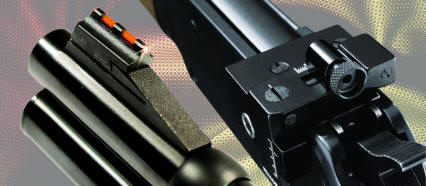|
Williams FP ("Fool Proof") Receiver Sight By Chuck Hawks  The products of the Williams Gunsight Company, a senior citizen among firearms oriented companies, have traditionally been innovative and well respected. At the top of their line of sights is the famous "Fool Proof" line of receiver mounted aperture (peep) sights. Williams continues to offer two lines of traditional receiver sights. These include the deluxe micrometer adjustable Model FP and the simpler and less expensive 5D hunting model. Both are available for a wide variety of rifles, including current and discontinued models. The receiver sight offers a simpler and more accurate sight picture than standard open sights. The eye looks through the aperture, making no attempt to focus on the rear sight. Focus is required only for the front sight and target. The eye will automatically look through the center of the aperture without conscious thought. The militaries of practically all major powers adopted the aperture sight before the beginning of World War II, testament to its simplicity, durability, and performance. And the rear aperture sight is still the standard aiming system for military rifles around the world. The aperture sight is not as common today on hunting rifles as it once was. Telescopic sights, which put the target and aiming mark in a single sighting plane, having become the preferred sighting system for most hunting rifles. The aperture sight still has its place in the scheme of things. It is fast to align and does not block the shooter's view of the lower half of the target, as does an open rear sight. The sight itself may be removed from its base and kept in reserve, leaving room for a low mounted scope. This makes receiver sights a popular option with many experienced African hunters, especially those who hunt dangerous game. The specific model of Williams receiver sight chosen for this review is the FP-1895, mounted on a Browning High Wall .45-70 single shot rifle. The FP sight is a good choice for this rifle, preserving its classic looks while offering faster and more accurate aiming than possible with any type of open sights. The Williams FP sight is manufactured from a strong black anodized aluminum alloy and is supplied with steel screws. This aluminum alloy has a tensile strength of 85,000 pounds, approximately 25% stronger than mild steel. It is rigid and resists flexing or bending better than its main competitor in the market place, the steel Lyman receiver sight. The Williams sight is also available for a considerably larger number of rifles. The 2004 MSRP was $68 ($80 with target knobs). Windage and elevation adjustments "click" in 1/4 MOA increments, and there are a series of white index marks for both the elevation and windage settings. On the test sight, it took approximately 20 "clicks" to move the sight one index mark in elevation. The sample FP sight reviewed here came with Williams target knobs, which allow easy finger adjustment. Target knobs are an accessory available on all FP sights. The standard flush adjustment screws are slotted. Once the rifle has been sighted-in, there are set screws in the rear of the sight bridge that can be tightened to avoid accidental movement, a pious idea for a hunting rifle. The adjustment process could hardly be simpler or more accurate. The supplied aperture disc is a good compromise for general purposes. For an extra wide field of view, simply remove the aperture disc and sight through the resulting large opening. This is the essentially a "ghost ring" sight. Once the FP aperture sight has been mounted on the rifle and bore sighted, it is ready to be sighted-in at the range. Get the sight set dead on at 25 yards, and then move back to 100 yards for final sight adjustment. The "Rifle Trajectory Table for Iron Sights," which can be found on the Tables, Charts and Lists Page, has trajectory information for most common calibers and loads. Due to its precise (and repeatable) adjustments, the FP sight is easy to zero-in. In the case of a .45-70 rifle shooting a 300 grain bullet at a MV of 1810 fps, the load I was using in the test rifle, set the sights to put the bullet 2.6" high at 100 yards. The maximum point blank range (+/- 3") is then 163 yards. The Williams FP receiver sight is clearly among the very best conventional (not optical) sights on the market. As with previous peep sights, The FP rear sight cut my 100 yard group size about in half compared to the open rear sight with which the Browning was equipped by the factory. |